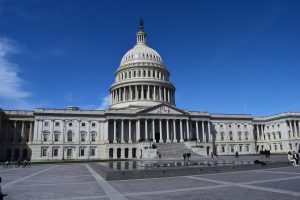Several scholars who study the use of guns for self-defense voiced concern about the CDC’s recent decision to remove information about how common they are after being pressured by gun-control advocates.
The researchers criticized the agency’s decision to remove a reference to the range of defensive gun use (DGU) estimates after the advocates complained the higher end of the scale made passing gun control more difficult. The advocates’ critiques centered on surveys conducted by retired Florida State University criminologist Gary Kleck, which found upwards of 2.5 million defensive uses per year in the 1990s. The CDC agreed to remove the reference to the estimates and a link to further research after a private meeting with just the gun-control advocates–something Kleck said was unbecoming of a scientific agency.
“If they were being honest and they really want it to come to the fairest, wisest decision, they would have reached out to me instead of simply asking gun-control advocates and scholars with a very pro-control bias what they think,” he told The Reload. “They clearly had no interest in getting to the facts.”
While much of the discussion between the CDC and the gun-control advocates centered on statistical and methodological critiques of Kleck’s work, it also veered into the explicitly political. After the private meeting, one of the advocates put the group’s motivations into stark terms.
“[T]hat 2.5 Million number needs to be killed, buried, dug up, killed again and buried again,” Mark Bryant, one of the attendees, wrote to CDC officials. “It is highly misleading, is used out of context and I honestly believe it has zero value – even as an outlier point in honest DGU discussions.”
Bryant, who runs the Gun Violence Archive (GVA), argued Kleck’s estimate has prevented new gun restrictions.
“And while that very small study by Gary Kleck has been debunked repeatedly by everyone from all sides of this issue [even Kleck] it still remains canon by gun rights folks and their supporting politicians and is used as a blunt instrument against gun safety regulations every time there is a state or federal level hearing,” he wrote in the same email. “Put simply, in the time that study has been published as ‘a CDC Study’ gun violence prevention policy has ground to a halt, in no small part because of the misinformation that small study provided.”
Despite initially standing behind the language the agency had used for years, CDC officials eventually agreed to change it, telling the advocates they would “make some edits to the content we discussed that I think will address the concerns you and other partners have raised.”
While Kleck’s research (which he stands behind) was the specific target of the revision, he wasn’t alone in his critique of how the CDC handled changing its description of DGUs.
Georgetown Professor William English, who produced a large survey last year with results similar to Kleck’s research, said the CDC did not contact him for input on the decision either. He argued the agency should have taken more care in considering changes requested by those with a clear political agenda.
“Whenever activists ask government agencies to change official information for political purposes, the merits of their arguments should be closely scrutinized,” English told The Reload.
He noted the CDC had identified the “serious methodological shortcomings” with the alternative DGU count suggested by Bryant and the other advocates, which generally doesn’t include incidents that aren’t reported in the news media. However, he said they didn’t recognize that survey-based estimates have been updated to counter many of the criticisms shared by the gun-control advocates or the outlier nature of their alternative.
“Although methodological criticisms have been made of Kleck’s estimates, multiple other surveys that are not vulnerable to these critiques have found well over a million defensive gun uses per year,” English said. “Thus, the weight of the evidence strongly counsels against lobbying efforts that seek to privilege GVA’s extraordinarily low estimates, which are the true outlier in this literature, while removing higher estimates that are based on representative surveys.”
Robert VerBruggen, a Manhattan Institute Fellow, has written extensively in the conservative publication National Review about DGUs. He has probed the weaknesses in high-end estimates, such as those produced by Kleck, and low-end estimates. He said the issue is not “the underlying statistical debate or the final text of the website” but the hidden process that resulted in the change.
“Estimates of ‘defensive gun uses’ vary extremely widely, and no one would have thought twice if the CDC’s fact sheet had–from the beginning–simply said that in general terms,” VerBruggen told The Reload. “What stands out is that, at a time when trust in our institutions runs low, and conservatives especially are cynical about the field of public health, the CDC removed a balanced summary of research findings from its website after being lobbied to do so by gun-control supporters — who in some cases were not shy about their political goals, and whose efforts were initially rebuffed on the entirely reasonable grounds that the original text was fine.”
The CDC justified its change in one of the FOIAd emails. It said it removed the range of DGU estimates and link to its review of research to clarify things because the “very wide range” might “raise more questions than it answered.”
“Because estimates of defensive gun use vary depending on the questions asked, populations studied, timeframe, and other factors related to study design, and given the wide variability in previous estimates and the desire to keep the fact sheet short and succinct,” the agency told the publication, “it made the most sense to remove the numbers from the fact sheet and acknowledge that additional research is necessary to understand defensive gun use prevalence, frequency, circumstances, and outcomes.”
Kleck rejected the CDC explanation, though. He argued the true motivation behind the change was evident.
“Saying they did it for the sake of brevity is a blatant lie; it’s ludicrous,” he said. “It’s not to be taken seriously. So, there has to be an alternative explanation. And given that it followed a lot of pressure from gun-control advocates, that is the most plausible explanation of why they did it.”
He agreed with Bryant’s assertion that the public’s understanding of how frequently Americans actually use guns for self-defense is key to whether or not there will be popular support for new gun restrictions. He said the understanding that DGUs are common is the main reason the ordinary people oppose gun prohibitions.
“It’s not the constitutional issue,” he said. “Only the advocacy groups, the anti-gun-control groups, actually care about the Second Amendment. The rest of the population they don’t even know what exactly it means or what its history is, or what militia meant when they mentioned militia and blah, blah, blah. That’s really not what’s behind popular opposition. That’s just, that’s irrelevant. But everybody can envision themselves being victimized and wish they had some way to minimize that.”
Regardless of the larger fight over gun ownership or how the CDC’s description ultimately impacts it, VerBruggen argued the way the agency went about changing its explanation of the critical issue left a stain on its reputation.
“Whatever the correct number of annual ‘DGUs’ turns out to be, this is a poor image for an agency that wants to fund gun research that could drive policy,” he said






